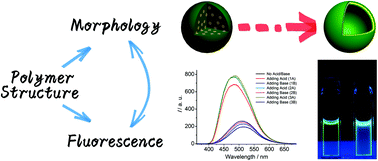Acid–base-controlled and dibenzylammonium-assisted aggregation induced emission enhancement of poly(tetraphenylethene) with an impressive blue shift†
Abstract
Three conjugated poly(tetraphenylethene)s grafted with dibenzo-24-crown-8 (DB24C8) groups, P-O, P-M and P-P, have been synthesized via Suzuki cross-coupling polymerization, in which the tetraphenylethene (TPE) units are connected at the ortho, meta and para positions, respectively. These conjugated polymers inherit the aggregation-induced emission feature of the TPE unit and thus their emission intensities increased significantly in the THF–water mixture solvents. The enhanced emission intensities highly depend on the connection modes of the TPE units and are in the order of P-O < P-M < P-P. Furthermore, the aggregation-induced emission enhancement (AIEE) feature can be activated by the acid–base-controlled complexation of DB24C8 groups with a dibenzylammonium chloride based molecule, protonated C12-2. The reduplicative complexation induces step-by-step emission enhancements together with morphological transitions from micellar to vesicular in the systems of P-O/C12-2 and P-M/C12-2. In the case of P-P/C12-2, of note is that the complexation not only leads to an AIEE feature but also a significant blue shift of the emission band from 515 to 483 nm. Both of these are really reversible under the acid–base-controlled condition. These polymer materials are of great importance for their potential application in the fields of optoelectronic devices and chemical and biomedical sensors.


 Please wait while we load your content...
Please wait while we load your content...